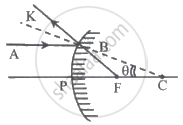Advertisements
Advertisements
प्रश्न
Answer the following question in detail.
What is a terrestrial telescope and an astronomical telescope?
उत्तर
- Telescopes used to see the objects on the Earth, like mountains, trees, players playing a match in a stadium, etc. are called terrestrial telescopes.
- In such a case, the final image must be erect. The eye lens used for this purpose must be concave and such a telescope is popularly called a binocular.
- Most of the binoculars use three convex lenses with proper separation. The image formed by the second lens is inverted with respect to the object. The third lens again inverts this image and makes the final image erect with respect to the object.
- An astronomical telescope is the telescope used to see objects like planets, stars, galaxies, etc. In this case, there is no necessity for an erect image. Such telescopes use a convex lens as an eye lens.
APPEARS IN
संबंधित प्रश्न
Answer the following question in detail.
How does magnifying power differ from linear or lateral magnification?
Answer the following question in detail.
What is the limitation in increasing the magnifying powers of a compound microscope?
Answer the following question in detail.
What is the limitation in increasing the magnifying powers of the astronomical telescope?
Why is oil-immersed objective preferred in a microscope?
What is the remedy of myopia?
What is the remedy of hypermetropia?
What is astigmatism? What is its remedy?
Obtain the equation for resolving the power of the microscope.
Discuss about astronomical telescope.
Explain the preliminary adjustments of the spectrometer.
A compound microscope has a magnifying power of 100 when the image is formed at infinity. The objective has a focal length of 0.5 cm and the tube length is 6.5 cm. What is the focal length of the eyepiece.
A light wave of wavelength λ is incident on a slit of width d. The resulting diffraction pattern is observed on a screen at a distance D. If linear width of the principal maxima is equal to the width of the slit, then the distance D is
There are four convex lenses L1, L2, L3 and L4 of focal length 2, 4, 6 and 8 cm, respectively. Two of these lenses from a telescope of length 10 cm and magnifying power 4. The objective and eye lenses are respectively
If astronomical telescope of length 1.53 m has magnifying power of magnitude 50, the values of fo and fe are ____________.
The magnifying power of a telescope is nine. When it is adjusted for parallel rays, the distance between the objective and eyepiece is 20 cm. The focal length of objective and eyepiece are respectively.
A simple microscope is used to see the object first in blue light and then in red light. Due to the change from blue to red light, what is the effect on its magnifying power?
The speed of light in media 'A' and 'B' are 2.0 × 1010 cm/s and 1.5 × 1010 cm/s respectively. A ray of light enters from medium B to A at an incident angle 'θ'. If the ray suffers total internal reflection, then ______.
Magnification produced by astronomical telescope for normal adjustment is 10 and length of telescope is 1.1 m. The magnification when the image is formed at least distance of distinct vision (D = 25 cm) is ______.
The image formed by an objective of a compound microscope is ______.
In the adjoining figure, AB represents the incident ray, and BK is the reflected ray. If angle BCF = θ, then ∠BFP is given by ______.

A camera objective has an aperture diameter of d. If the aperture is reduced to diameter d/2, the exposure time under identical conditions of light should be made ______.
